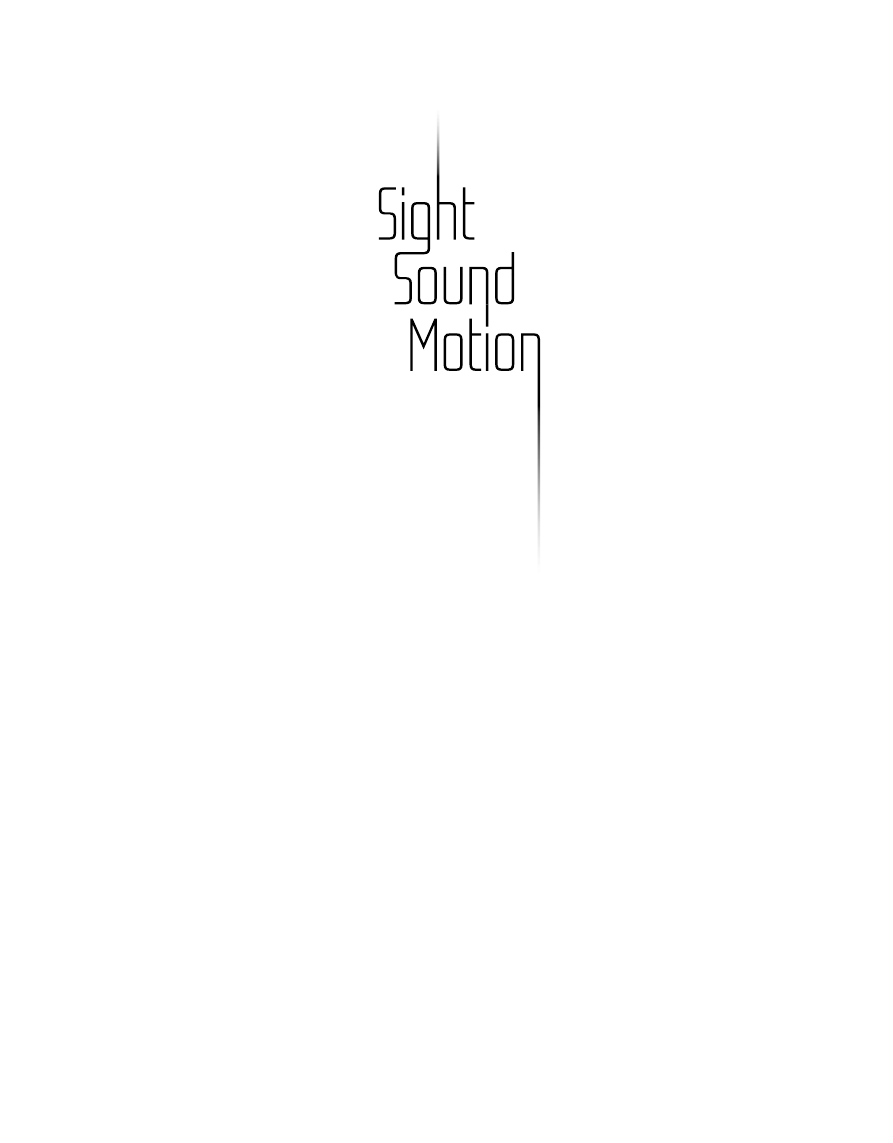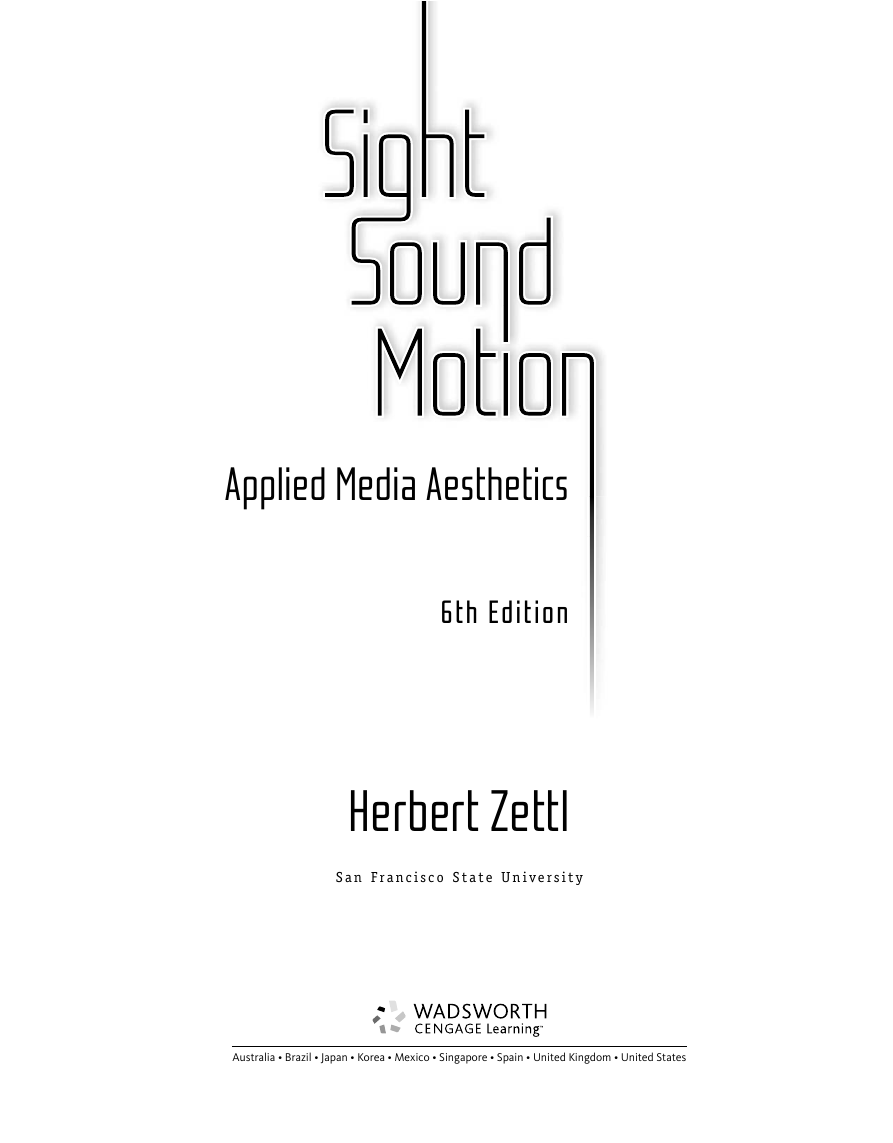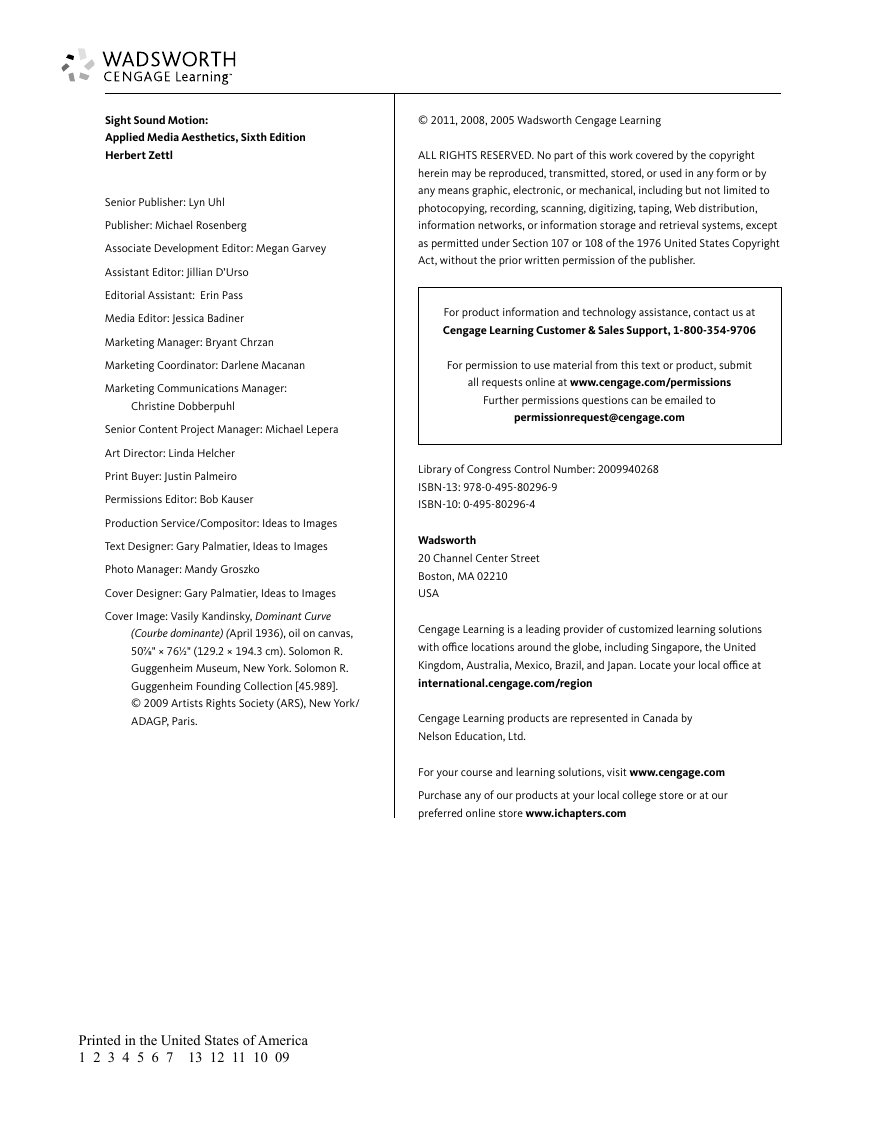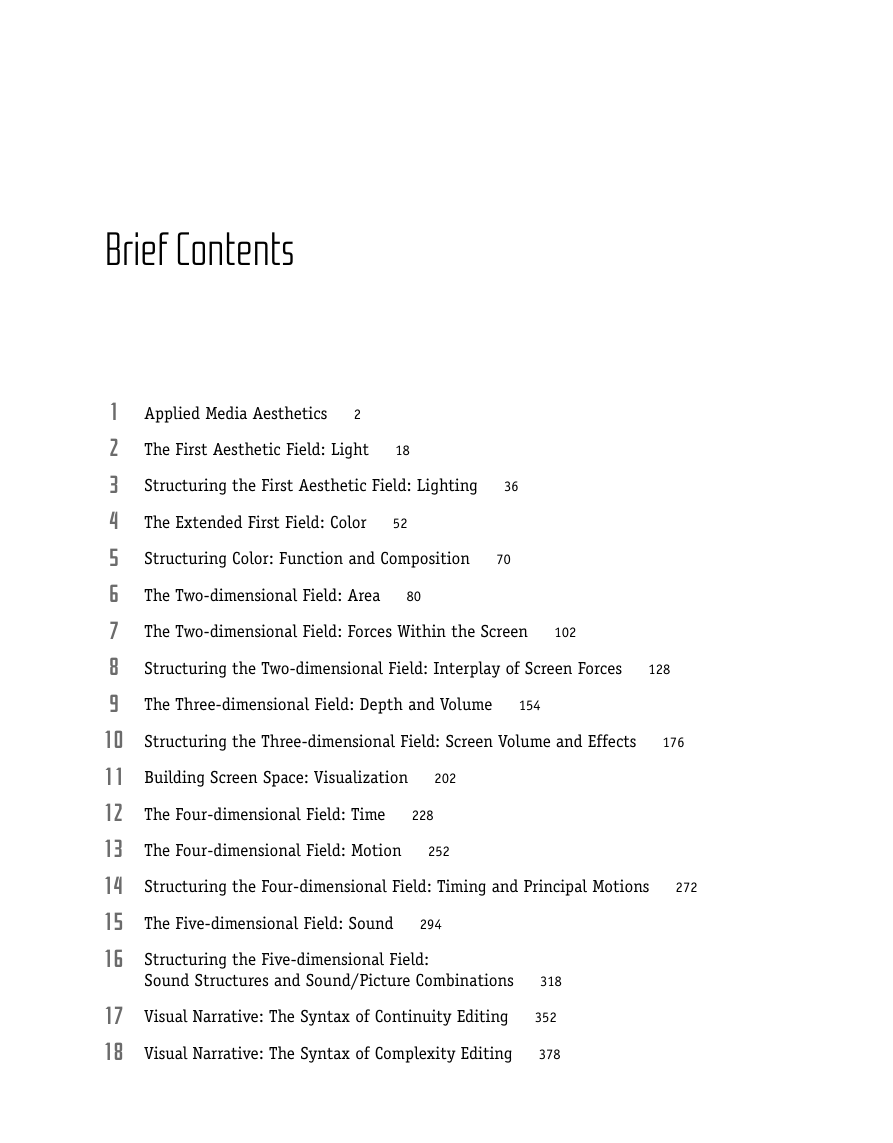Front Cover
Title Page
Copyright
Contents
About the Author
Preface
Prologue
1 Applied Media Aesthetics
APPLIED MEDIA AESTHETICS: DEFINITION
APPLIED AESTHETICS AND ART
Art and Experience
APPLIED AESTHETICS AND CONTEXTUAL PERCEPTION
Stabilizing the Environment
Selective Seeing and Selective Perception
THE POWER OF CONTEXT
Associative Context
Aesthetic Context
THE MEDIUM AS STRUCTURAL AGENT
APPLIED MEDIA AESTHETICS: METHOD
FUNDAMENTAL IMAGE ELEMENTS
Analysis and Synthesis
Content
RESPONSIBILITY
SUMMARY
NOTES
2 The First Aesthetic Field: Light
THE NATURE OF LIGHT
LIGHTING PURPOSES AND FUNCTIONS
THE NATURE OF SHADOWS
Attached and Cast Shadows
Falloff
OUTER ORIENTATION FUNCTIONS: HOW WE SEE AN EVENT
Spatial Orientation
Tactile Orientation
Time Orientation
INNER ORIENTATION FUNCTIONS: HOW WE FEEL ABOUT AN EVENT
Establishing Mood and Atmosphere
Above- and Below-eye-level Key-light Position
Predictive Lighting
Light and Lighting Instruments as Dramatic Agents
SUMMARY
NOTES
3 Structuring the First Aesthetic Field: Lighting
STANDARD LIGHTING TECHNIQUES
CHIAROSCURO LIGHTING
Analysis of Chiaroscuro Lighting
Functions of Chiaroscuro Lighting
SPECIFIC CHIAROSCURO LIGHTING TYPES
Rembrandt Lighting
Cameo Lighting
FLAT LIGHTING
Functions of Flat Lighting
SILHOUETTE LIGHTING
MEDIA-ENHANCED AND MEDIA-GENERATED LIGHTING
SINGLE- AND MULTICAMERA LIGHTING
Single-camera Lighting
Multicamera Lighting
THE AESTHETIC EDGE: UNUSUAL LIGHTING
SUMMARY
NOTES
4 The Extended First Field: Color
WHAT IS COLOR?
HOW WE PERCEIVE COLOR
Basic Physiological Factors
Basic Aesthetic Perception Factors
Grayscale
Color Models
Compatible Color
HOW WE MIX COLOR
Additive Color Mixing
Subtractive Color Mixing
Mixed Mixing
RELATIVITY OF COLOR
Light Environment
Surface Reflectance
Color Temperature
Surrounding Colors
Color Juxtaposition
Brightness and Color Constancy
COLORS AND FEELINGS
Warm and Cold Colors
COLOR ENERGY
SUMMARY
NOTES
5 Structuring Color: Function and Composition
INFORMATIONAL FUNCTION OF COLOR
Color Symbolism
COMPOSITIONAL FUNCTION OF COLOR
Color Energy
THE AESTHETIC EDGE: EXPRESSIVE FUNCTION OF COLOR
Expressing the Essential Quality of an Event
Adding Excitement and Drama
Establishing Mood
Desaturation Theory
Colorizing Film
Television Commercials
SUMMARY
NOTES
6 The Two-dimensional Field: Area
ASPECT RATIO
Horizontal Orientation
Standard Aspect Ratios
Framing in the 4 × 3 Aspect Ratio
Framing in the 16 × 9 Aspect Ratio
FLEXIBLE ASPECT RATIO
Matching Aspect Ratios
Aspect Ratios of Mobile Video Media
Secondary Frames
Screens Within the Screen
THE AESTHETICS OF SIZE
OBJECT SIZE
Knowledge of Object
Relation to Screen Area
Scale
IMAGE SIZE
Mobile Video Media as Companion
Image Size and Relative Energy
SUMMARY
NOTES
7 The Two-dimensional Field: Forces Within the Screen
MAIN DIRECTIONS: HORIZONTAL AND VERTICAL
Tilting the Horizontal Plane
MAGNETISM OF THE FRAME
Headroom
Pull of the Top Edge
Pull of the Side Edges
Pull of Entire Frame
Attraction of Mass
ASYMMETRY OF THE FRAME
Up/Down Diagonals
Screen-left and Screen-right Asymmetry
FIGURE AND GROUND
Figure/Ground Characteristics
PSYCHOLOGICAL CLOSURE
Gestalt
High- and Low-defi nition Images
Facilitating Closure
VECTORS
Vector Field
Vector Types
Vector Magnitude
Vector Directions
SUMMARY
NOTES
8 Structuring the Two-dimensional Field: Interplay of Screen Forces
STABILIZING THE FIELD THROUGH DISTRIBUTION OF GRAPHIC MASS AND MAGNETIC FORCE
Screen-center
Off -center
Counterweighting
STABILIZING THE FIELD THROUGH DISTRIBUTION OF VECTORS
Structural Force of Index Vectors
Noseroom and Leadroom
Converging Vectors
Graphic Vectors
STAGES OF BALANCE
Static Balance
Dynamic Balance
Pushing Dynamics
Unbalanced Screen Space
OBJECT FRAMING
Facilitating Closure
Graphic Cues
Premature Closure
Natural Dividing Lines
Illogical Closure
THE AESTHETIC EDGE: UNUSUAL COMPOSITIONS
MULTIPLE SCREENS
Increased Information Density
DIVIDING THE SCREEN: GRAPHIC BLOCKS
DIVIDING THE SCREEN: SCREENS WITHIN THE SCREEN
SUMMARY
NOTES
9 The Three-dimensional Field: Depth and Volume
THE Z-AXIS
GRAPHIC DEPTH FACTORS
Overlapping Planes
Relative Size
Height in Plane
Linear Perspective
Aerial Perspective
DEPTH CHARACTERISTICS OF LENSES
Overlapping Planes: Wide-angle Lens
Overlapping Planes: Narrow-angle Lens
Relative Size: Wide-angle Lens
Relative Size: Narrow-angle Lens
Linear Perspective: Wide-angle Lens
Linear Perspective: Narrow-angle Lens
Working with Aerial Perspective
3D STEREOSCOPIC PROJECTION
Stereoscopic 3D Versus Standard 3D: Technical Difference
Stereoscopic 3D Versus Standard 3D: Aesthetic Difference
SUMMARY
NOTES
10 Structuring the Three-dimensional Field: Screen Volume and Effects
VOLUME DUALITY
Dominant Positive Volume
Dominant Negative Volume
Applications of Volume Duality
Z-AXIS ARTICULATION
Narrow-angle Lens distortion
Wide-angle Lens Distortion
Z-AXIS BLOCKING
SPECIAL EFFECTS AND SPATIAL PARADOXES
Graphication
First- and Second-order Space
Personification
Topological and Structural Changes
Spatial Paradoxes
Stereoscopic Projections
SUMMARY
NOTES
11 Building Screen Space: Visualization
DEDUCTIVE AND INDUCTIVE VISUAL APPROACHES
Deductive Approach
Inductive Approach
WAYS OF LOOKING
Looking At an Event
Looking Into an Event
Creating an Event
FIELD OF VIEW
POINT OF VIEW
POV: Looking Up and Looking Down
POV: Objective Viewpoint to Subjective Point of View
POV: Subjective Camera
ANGLES
Angles for Continuity
Angles for Multiple Viewpoints
Angles for Event Intensification
Angles for Setting Style
STORYBOARD
SUMMARY
NOTES
12 The Four-dimensional Field: Time
THE SIGNIFICANCE OF TIME
WHAT IS TIME?
TYPES OF TIME
Objective Time
Subjective Time
Biological Time
TIME DIRECTION
Past/Present/Future
The Present as Subjective Time
Transcending Time
CONTROLLING SUBJECTIVE TIME
Event Density
Event Intensity
Experience Intensity
LIVE TELEVISION
Live Television and Event Time
Live Television and Event Dependency
Live Television and Open Future
VIDEO RECORDING
Uninterrupted Video Recording of a Live Event
Instant Replays
TIME IN EDITED VIDEO AND FILM
SUMMARY
NOTES
13 The Four-dimensional Field: Motion
PERCEIVED MOTION
FILM MOTION AND ITS BASIC STRUCTURAL UNIT
VIDEO MOTION AND ITS BASIC STRUCTURAL UNIT
AESTHETIC IMPLICATIONS: THE FILM LOOK
The Film Look
LARGE-SCREEN DIGITAL CINEMA
MOTION FRAMES OF REFERENCE
Motion Paradox
Induced Motion Through Figure/Ground Reversal
PERCEIVED SPEED
Object Speed
Lens Choice and Blocking
SLOW AND ACCELERATED MOTION
Slow Motion
Accelerated Motion
SYNTHETIC MOTION
SUMMARY
NOTES
14 Structuring the Four-dimensional Field: Timing and Principal Motions
TYPES OF OBJECTIVE TIME: TIMING
Clock Time
Running Time
Sequence Time
Scene Time
Shot Time
Story Time
TYPES OF SUBJECTIVE TIME: PACE AND RHYTHM
Pace
Rhythm
PLOT TIME AND CHARACTER TIME
PRINCIPAL MOTIONS AND THEIR FUNCTIONS
Primary Motion and Functions
Secondary Motion and Functions
Tertiary Motion and Functions
SUMMARY
NOTES
15 The Five-dimensional Field: Sound
SOUND AND NOISE
VIDEO AND FILM SOUND
Television Sound
Film Sound
LITERAL AND NONLITERAL SOUNDS
Literal, or Diegetic, Sounds
Nonliteral, or Nondiegetic, Sounds
Literal and Nonliteral Sound Combinations
The Importance of Context
INFORMATION FUNCTION OF SOUND
Dialogue
Direct Address
Narration
OUTER ORIENTATION FUNCTIONS OF SOUND
Space
Time
Situation
External Conditions
INNER ORIENTATION FUNCTIONS OF SOUND
Mood
Internal Condition
Energy
STRUCTURAL FUNCTIONS OF SOUND
Rhythm
Figure/Ground
Sound Perspective
Sound Continuity
SUMMARY
NOTES
16 Structuring the Five-dimensional Field: Sound Structures and Sound/Picture Combinations
ELEMENTS OF SOUND
Pitch
Timbre
Duration
Loudness (Dynamics)
Attack/Decay
BASIC SOUND STRUCTURES
Melody
Harmony
Homophony
Polyphony
STRUCTURED IMPROVISATIONS AND NOTATION OF INDETERMINATE MUSIC
PICTURE/SOUND COMBINATIONS
Homophonic Structures
Polyphonic Structures
PICTURE/SOUND MATCHING CRITERIA
Historical/Geographical
Thematic
Tonal
Structural
STRUCTURAL ANALYSIS
SUMMARY
NOTES
17 Visual Narrative: The Syntax of Continuity Editing
EDITING PURPOSE
Instantaneous Editing
VISUAL SYNTAX OF CONTINUITY EDITING
GRAPHIC VECTOR CONTINUITY PRINCIPLES
INDEX VECTOR CONTINUITY PRINCIPLES
Continuing, Converging, and Diverging Index Vectors
Index Vector–Target Object Continuity
Successive Z-axis Index Vectors
Index Vector Line and Position Continuity
MOTION VECTOR CONTINUITY PRINCIPLES
Continuing, Converging, and Diverging Motion Vectors
Z-axis Motion Vectors and Continuity
Motion Vector Line
ADDITIONAL CONTINUITY FACTORS
Action Continuity
Subject Continuity
Color Continuity
Appearance Continuity
Audio Continuity
SUMMARY
NOTES
18 Visual Narrative: The Syntax of Complexity Editing
ANALYTICAL MONTAGE
Sequential Analytical Montage
Sectional Analytical Montage
IDEA-ASSOCIATIVE MONTAGE
Comparison Montage
Collision Montage
METRIC MONTAGE
AUDIO/VIDEO MONTAGE
Sequential Analytical A/V montage
MEDIA AESTHETICS AND THE HUMAN CONDITION
SUMMARY
NOTES
Glossary
Bibliography
Photo Credits
Index
















 2023年江西萍乡中考道德与法治真题及答案.doc
2023年江西萍乡中考道德与法治真题及答案.doc 2012年重庆南川中考生物真题及答案.doc
2012年重庆南川中考生物真题及答案.doc 2013年江西师范大学地理学综合及文艺理论基础考研真题.doc
2013年江西师范大学地理学综合及文艺理论基础考研真题.doc 2020年四川甘孜小升初语文真题及答案I卷.doc
2020年四川甘孜小升初语文真题及答案I卷.doc 2020年注册岩土工程师专业基础考试真题及答案.doc
2020年注册岩土工程师专业基础考试真题及答案.doc 2023-2024学年福建省厦门市九年级上学期数学月考试题及答案.doc
2023-2024学年福建省厦门市九年级上学期数学月考试题及答案.doc 2021-2022学年辽宁省沈阳市大东区九年级上学期语文期末试题及答案.doc
2021-2022学年辽宁省沈阳市大东区九年级上学期语文期末试题及答案.doc 2022-2023学年北京东城区初三第一学期物理期末试卷及答案.doc
2022-2023学年北京东城区初三第一学期物理期末试卷及答案.doc 2018上半年江西教师资格初中地理学科知识与教学能力真题及答案.doc
2018上半年江西教师资格初中地理学科知识与教学能力真题及答案.doc 2012年河北国家公务员申论考试真题及答案-省级.doc
2012年河北国家公务员申论考试真题及答案-省级.doc 2020-2021学年江苏省扬州市江都区邵樊片九年级上学期数学第一次质量检测试题及答案.doc
2020-2021学年江苏省扬州市江都区邵樊片九年级上学期数学第一次质量检测试题及答案.doc 2022下半年黑龙江教师资格证中学综合素质真题及答案.doc
2022下半年黑龙江教师资格证中学综合素质真题及答案.doc